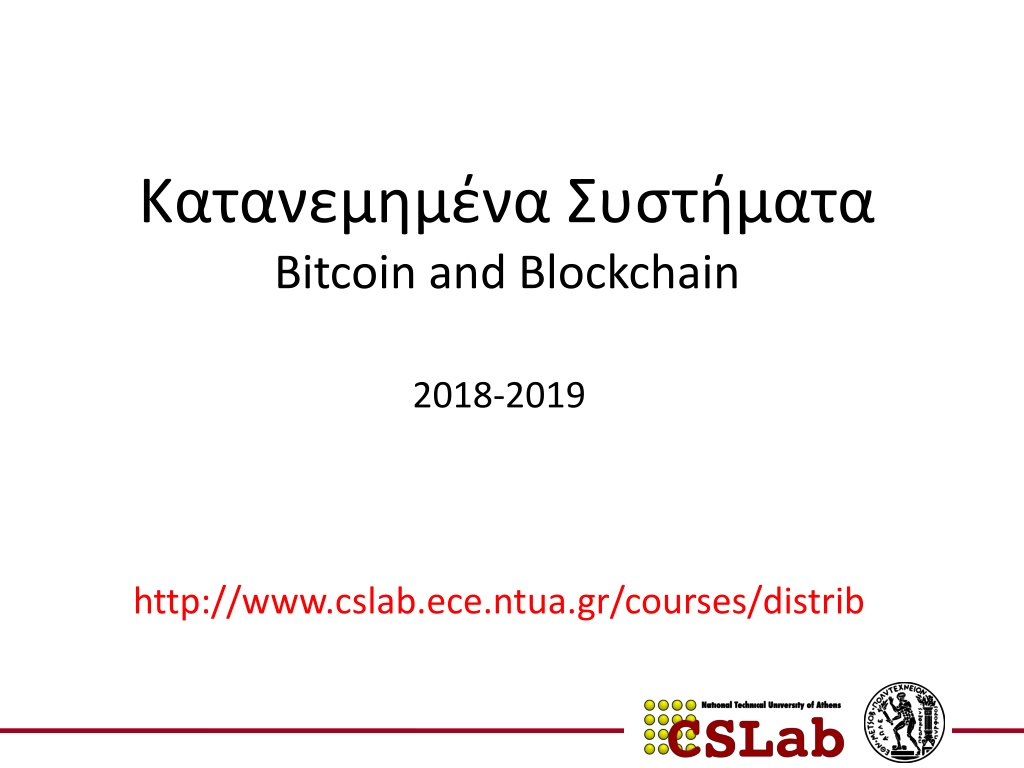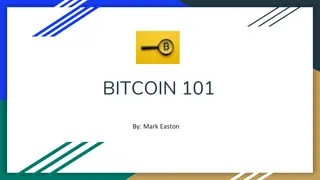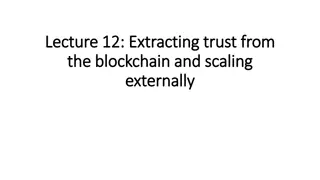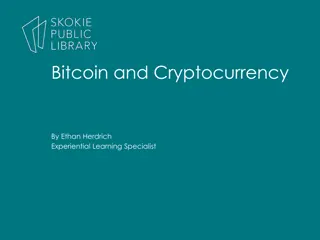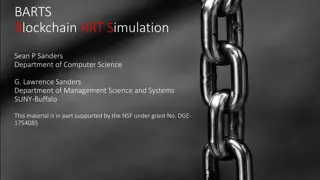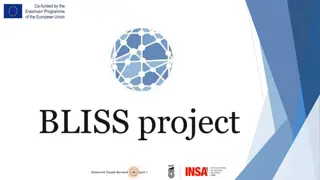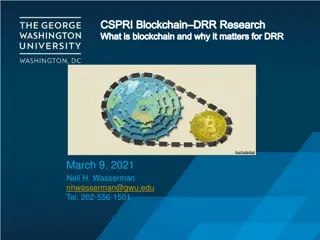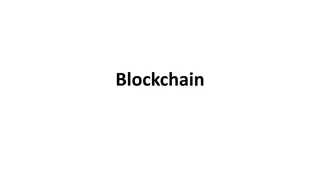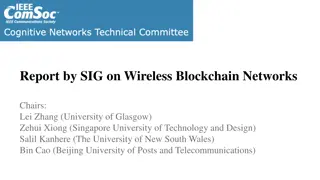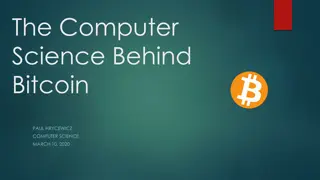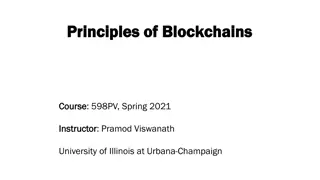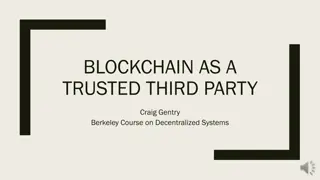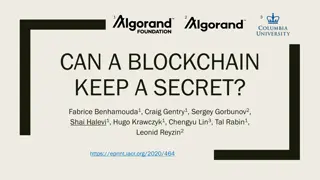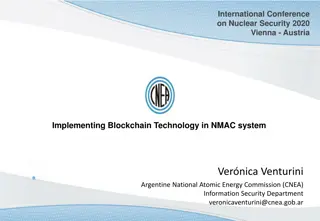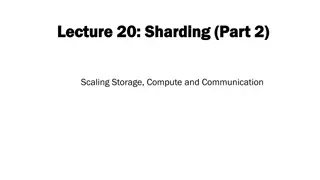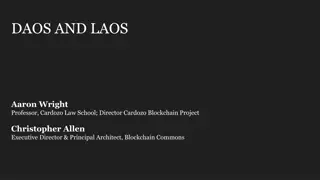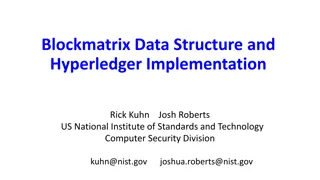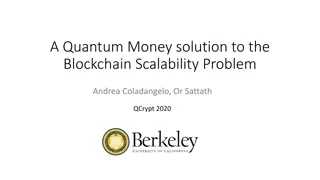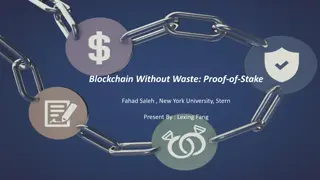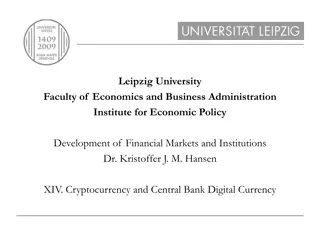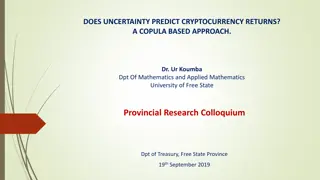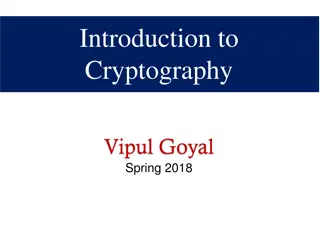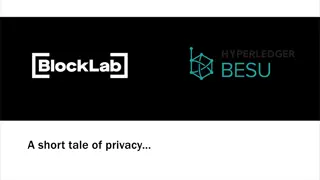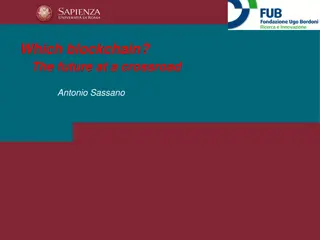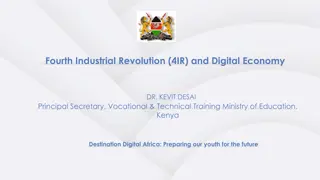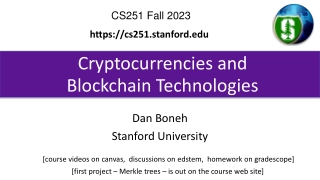Exploring Bitcoin and Blockchain: A Comprehensive Overview
Delve into the world of Bitcoin and Blockchain from its inception to its significance in the contemporary market. Understand the underlying technology, value proposition, historical timeline, features, and challenges posed by virtual currencies. Discover the intricacies of distributed secure ledgers, decentralized peer-to-peer transactions, deflationary rewards, and the consensus-driven nature of the Bitcoin ecosystem.
Download Presentation

Please find below an Image/Link to download the presentation.
The content on the website is provided AS IS for your information and personal use only. It may not be sold, licensed, or shared on other websites without obtaining consent from the author. Download presentation by click this link. If you encounter any issues during the download, it is possible that the publisher has removed the file from their server.
E N D
Presentation Transcript
Bitcoin and Blockchain 2018-2019 http://www.cslab.ece.ntua.gr/courses/distrib
Blockchain Defined Simply defined a Blockchain is little more than a: Distributed Secure Ledger (logfile) A digital currency was in a lot of ways the first demonstrable use 2
What is Bitcoin A protocol that supports a decentralized, pseudo-anonymous, peer-to-peer digital currency A publicly disclosed linked ledger of transactions stored in a blockchain A reward driven system for achieving consensus (mining) based on Proofs of Work for helping to secure the network An economy with an eventual cap of about 21M bitcoins 3
Bitcoin Whitepaper 2008.10.31 4 * Halloween
Features of Bitcoin Essentially it s deflationary the reward is cut in half every four years Nearly infinitely divisible currency units supporting eight decimal places 0.00000001 (known as a Satoshi) Nominal transaction fee s paid to the network Same cost to send $.01 as $1,000,000 Consensus driven no central authority Counterfeit resilient Cannot add coins arbitrarily Cannot be double-spent Non-repudiation aka gone baby gone no recourse and no one to appeal to return sent tokens 5
When did it start? Satoshi Nakamoto created the reference implementation that began with a Genesis Block of 50 coins 2008 August 18 Domain name "bitcoin.org" registered[1]. October 31 Bitcoin design paper published November 09 Bitcoin project registered at SourceForge.net 2009 January 3 Genesis block established at 18:15:05 GMT January 9 Bitcoin v0.1 released and announced on the cryptography mailing list January 12 First Bitcoin transaction, in block 170 from Satoshi to Hal Finney https://en.bitcoin.it/wiki/History 6
Why does it have value? The worth of a thing is the price it will bring. 7
Why does it matter? 16 Billion Dollar Market Cap! 8 http://coinmarketcap.com
BitCoin: Challenges All virtual currency must address the following challenges: Creation of a virtual coin/note How is it created in the first place? How do you prevent inflation? (What prevents anyone from creating lots of coins?) Validation Is the coin legit? How do you prevent a coin from double-spending? BitCoin takes a infrastructure-less approach Rely on proof instead of trust No central bank or clearing house
BitCoin: Motivation Rely on proof instead of trust Current online transactions rely on a trusted party (e.g, VISA) They take some risk, manage fraud, and get paid a fee. Buyer and Seller protection in online transcations Buyer pays, but the seller doesn t deliver Solved by using an escrow (Buyer protection) Seller delivers, buyer pays, but the buyer makes a claim. VISA refunds; the payment is reversed. Either the seller is penalized and/or VISA charges more fee to handle these cases. Some behaviors are fraudulent. BitCoin gets rid of this trusted middleman, by being able to directly show the cryptographic proof that the money is transferred.
Four components in secure communication Authentication Confidentiality Integrity Availability
What do we want to secure? Authentication (Who am I talking to?) Identification and assurance of the origin of information Confidentiality (Is my data hidden?) Concealment of information Integrity (Has my data been modified?) Prevent improper and unauthorized changes Availability (Can I use the resources?) The ability to use the information or resource desired
From the perspective of BitCoin Authentication Am I paying the right person? Not some other impersonator? Integrity Is the coin double-spent? Can an attacker reverse or change transactions? Availability Can I make a transaction anytime I want? Confidentiality Not very relevant. But privacy is important.
From the perspective of BitCoin Authentication Public Key Crypto: Digital Signatures Am I paying the right person? Not some other impersonator? Integrity Digital Signatures and Cryptographic Hash Is the coin double-spent? Can an attacker reverse or change transactions? Availability Can I make a transaction anytime I want? Confidentiality Not very relevant. But privacy is important.
Cryptographic Hash Functions Consistent: H(X) always yields same result One-way: given Y, hard to find X s.t. H(X) = Y Collision resistant: given H(W) = Z, hard to find X such that H(X) = Z Fixed Size Hash Hash Fn Message of arbitrary length e.g. SHA256 ->256 bits
Collision resistant Find a collision: Try 2130 randomly chosen inputs 99,8% chance that two of them collide Takes too long to matter
SHA256 In practice, we hope that SHA256 behaves like a random oracle . SHA256:TextFiles 0, ,2256 1 Calculation: If we made all computers in the world compute SHA256 It takes ~ 40 14 109years to find ?1 ?2 s.t. SHA256 ?1 = SHA256 ?2.
Application: Hash as a message digest H(x) = H(y) then safe to assume x=y To recognize a file that we saw before, just remember its hash Useful because it s small
One way Given H(x), infeasible to find x Distributions of values should be very spread out (e.g., uniform)
Digital Signature Key Generation Signing Verification Bob Alice (Public) Alice (Secret) Alice
Digital Signature Key Generation Signing Verification Alice (Public) (Public) Alice (Secret) Alice Alice Bob
Goal: Bob should be sure that the message originates from Alice. Digital Signature Key Generation Signing Verification Alice (Public) Bob Message Alice (Public) Alice (Secret) A Alice
Digital Signature Key Generation Secret Key Message Secret Key Public Key Signing A A Public Key Message Verification Security (informal): You cannot produce valid signatures without the secret key.
Back to BitCoins Validation Is the coin legit? (proof-of-work) Use of Cryptographic Hashes How do you prevent a coin from double-spending? Broadcast to all nodes Creation of a virtual coin/note How is it created in the first place? Provide incentives for miners How do you prevent inflation? (What prevents anyone from creating lots of coins?) Limit the creation rate of the BitCoins
ATTEMPT #1 We now try to build bitcoin but we will fail.
Goals We want some kind of digital money . Everyone can participate. No central instance no bank.
Setting A network of computers. Every computer can send messages to some other computers.
Basic idea Every computer maintains a table: who owns what? Alice (Public) 10 BTC Bob (Public) 0.2 BTC Charlie (Public) We will need: all computers have the same table. 17 BTC Dora (Public) 0.001 BTC Eliza (Public) 2 BTC Remark: The public keys are just bit strings.
Sending Bitcoins To send money, we use transactions. These are messages like this: Transfer 0.1 BTC Alice (Public) from In short , transactions look like this: Bob (Public) to F T $ A
Sending Bitcoins I LL send 0.1 Bitcoin to Bob. F T $ Alice Protocol: sending BTC Protocol: participating On valid transactions: 1. Craft a transaction. 1. Update ledger 2. Give it to your computer. 2. Relay transaction
Double Spending Thanks ! I can exploit this! Bob These transactions spend previously spent bitcoins! Thanks ! Black Hat Black Hat prepares two transactions: Alice : Give BTC from Black Hat to Alice : Give BTC from Black Hat to Bob
Double Spending The bad guy spends the same Bitcoins with two different transactions and . Computers receiving transaction will have a different ledger than computers receiving transaction .
Consensus Protocols We need a protocol to agree on a transaction. Consensus protocols . Studied since 1980, starting with Pease, Shostak, Lamport. Huge literature! Main idea for protocols: What transaction are you using? Protocols work if (say) > 70% of the computers follow the protocol.
This solution does not help us! Design goal: Everyone can participate. By running a special program, a bad guy controls many virtual computers. Like this, he can make different participants believe different things. I will gladly participate With 1 000 virtual machines!
BITCOINS CONSENSUS PROTOCOL Step 1: How does the protocol look like? Step 2: What happens if people cheat?
Blocks 0000031105830 A block ? contains RH(? ) for another block ? , a list of transactions, and an arbitrary number nonce . Block ? is valid if the first ? = 5 digits of the hash of ? are all zero. 8046465385222 RH 0000077326777
Blocks To find a valid block, we try different values for this string ( nonce ). On average, after 10?= 100000 tries, we find a valid block. Bitcoin chooses ? on the fly such that this takes about 10 minutes. Block ? is valid if the first ? = 5 digits of RO ? are all zero.
Blocks If we have a block, we can find a next block : Take RH(? ) from the previous block ? . Add transactions. = Try different values for this string until the hash starts with ? zeros.
BitCoin Network Each P2P node runs the following algorithm [bitcoin]: New transactions are broadcast to all nodes. Each node collects new transactions into a block. Each node works on finding a proof-of-work for its block. (Hard to do. Probabilistic. The one to finish early will probably win.) When a node finds a proof-of-work, it broadcasts the block to all nodes. Nodes accept the block only if all transactions in it are valid (digital signature checking) and not already spent (check all the transactions). Nodes express their acceptance by working on creating the next block in the chain, using the hash of the accepted block as the previous hash.
A Tree of Blocks If we have a block, with a bit of work, we can find a next block = ...and yet another next block or a block which continues here and so on.
A Tree of Blocks In general, we can build a tree of blocks like this. But only ever downwards!
Tie breaking Two nodes may find a correct block simultaneously. Keep both and work on the first one If one grows longer than the other, take the longer one Two different block chains (or blocks) may satisfy the required proof-of-work.
The Protocol for Finding Blocks Protocol: finding blocks 1. Take the longest chain you can find. 2. Collect transactions. 3. Find a new valid block here. 4. Publish it.
The Protocol for Participants Protocol: To know who owns BTC 1. Take the longest chain you can find. 2. Process the transactions in this chain in order.
Reverting is hard Reverting gets exponentially hard as the chain grows. 2. Recompute nonce 3. Recompute the next nonce 1. Modify the transaction (revert or change the payer)
Practical Limitation At least 10 mins to verify a transaction. Agree to pay Wait for one block (10 mins) for the transaction to go through. But, for a large transaction ($$$) wait longer. Because if you wait longer it becomes more secure. For large $$$, you wait for six blocks (1 hour).
Why work to find blocks? Many people are trying to find blocks, which uses a lot of resources A real lot! This is called mining .
Block reward If you find a block, you get bitcoins as a reward. Every transaction specifies a fee. It goes to the person who puts the transaction into a valid block. Transfer Transfer 0.1 BTC 0.1 BTC Alice (Public) (Public) Alice from from Bob (Public) (Public) Bob to to A A Fee: 0.001 BTC
Recap: The Bitcoin Protocol Protocol: participate Relay valid transactions. Relay valid blocks in the longest chain. Work with the longest chain. Protocol: miners Collect valid transactions. Publish valid blocks which extend the longest chain.
Step 1: How does the protocol look like? BITCOIN S CONSENSUS PROTOCOL Step 2: What happens if people cheat?
